
Tortoises are reptiles of the family Testudinidae of the order Testudines. Like other turtles, tortoises have a shell to protect from predation and other threats. The shell in tortoises is generally hard, and like other members of the suborder Cryptodira, they retract their necks and heads directly backward into the shell to protect them.

Giant tortoises are any of several species of various large land tortoises, which include a number of extinct species, as well as two extant species with multiple subspecies formerly common on the islands of the western Indian Ocean and on the Galápagos Islands.

The Bolson tortoise, also called the Mexican giant tortoise or yellow-margined tortoise, is a species of tortoise from North America. Of the six North American tortoise species, it is the largest, having a carapace length of about 46 cm (18 in). It lives in a region of the Chihuahuan Desert known as the Bolsón de Mapimí, which is located in north-central Mexico.
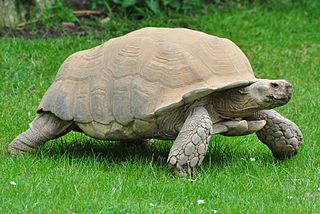
The African spurred tortoise, also called the sulcata tortoise, is a species of tortoise inhabiting the southern edge of the Sahara desert in Africa. It is the largest mainland species of tortoise in the world, and the third-largest in the world. It is the last remaining species in its genus, Centrochelys, with the five other species in the family already extinct.
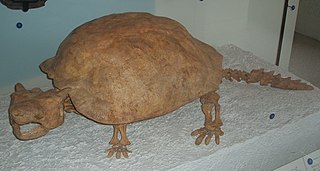
Meiolania is an extinct genus of meiolaniid stem-turtle native to Australasia from the Middle Miocene to Late Pleistocene and possibly Holocene. It is best known from fossils found on Lord Howe Island, though fossils are known from mainland Australia, New Caledonia, and possibly Vanuatu and Fiji.
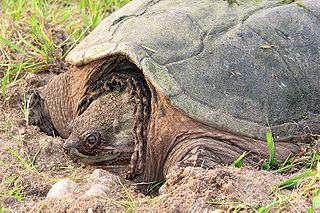
Chelydra is one of the two extant genera of the snapping turtle family, Chelydridae, the other being Macrochelys, the much larger alligator snapping turtle. The snapping turtles are native to the Americas, with Chelydra having three species, one in North America and two in Central America, one of which is also found in northwestern South America.
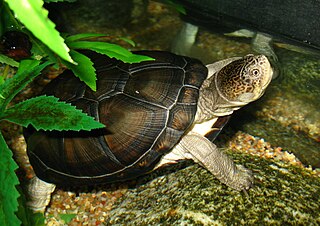
Pelusios is a genus of African side-necked turtles. With 17 described species, it is one of the most diverse genera of the turtle order (Testudines).
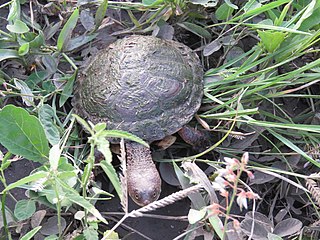
The Chaco side-necked turtle or Chaco sideneck turtle is a species of turtle in the family Chelidae. It is found in Argentina, Paraguay, and possibly Bolivia. Its natural habitat is subtropical or tropical moist montane forests. The turtle possesses long horny spurs on its upper thighs. It is 18 cm in shell length. Like other members of its genus, the turtle buries itself in the mud when the streams run dry, a behaviour possibly parallel to the winter hibernating behaviours of turtles further north.

Elseya is a genus of large side-necked turtles, commonly known as Australian snapping turtles, in the family Chelidae. Species in the genus Elseya are found in river systems in northern and northeastern Australia and throughout the river systems of New Guinea. They are identified by the presence of alveolar ridges on the triturating surfaces of the mouth and the presence of a complex bridge strut.

The Western New Guinea stream turtle or New Guinea snapping turtle is a species of freshwater turtle in the Chelidae family. It is found in the Bird's Head Peninsula and the Bomberai Peninsula west of Cenderawasih Bay, and on the island of Waigeo of West Papua, Indonesia.
Pelusios broadleyi, commonly known as the Turkana mud turtle, Broadley's mud turtle, or the Lake Turkana hinged terrapin, is a species of turtle in the family Pelomedusidae. The species is native to eastern Africa.

Hesperotestudo is an extinct genus of tortoise native to North and Central America from the Oligocene to the Late Pleistocene. Species of Hesperotesudo varied widely in size, with the largest unnamed species from El Salvador reaching 150 cm (4.9 ft) in carapace length, larger than that of extant giant tortoises. Historically considered a subgenus of Geochelone, it is now considered to be distantly related to that genus. Its closest relatives are the extant Gopherus and the extinct Stylemys. The ancestor of the three genera arrived in North America during the Early Eocene. The bodies of Hesperotesudo species were extensively covered with large dermal ossicles, which in life were covered in keratin. It has been suggested that species of Hesperotestudo were relatively tolerant of cold weather. Hesperotestudo became extinct at the end of the Pleistocene and beginning of the Holocene co-incident with the arrival of the first humans in North America, and sites have been found where Hesperotestudo were butchered.
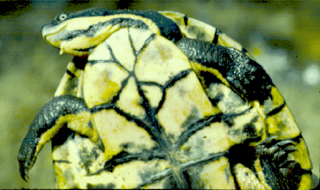
The Myuchelys is a genus of turtles, the Australian saw-shelled turtles, in the family Chelidae and subfamily Chelodininae. They inhabit the headwaters and tributaries of rivers within their range and this led to the name Myuchelys, which is formed from the Aboriginal word myuna meaning clear water and the Greek chelys meaning turtle. They have a short neck and the intergular scute completely separates the gular scutes. They have no alveolar ridge separating them from the snapping turtles of the genus Elseya.

Chelonoidis is a genus of turtles in the tortoise family erected by Leopold Fitzinger in 1835. They are found in South America and the Galápagos Islands, and formerly had a wide distribution in the West Indies.

Megalochelys is an extinct genus of cryptodiran tortoises that lived from the Miocene to Pleistocene. They are noted for their giant size, which is among the largest of any known testudine, with a maximum carapace length over 2 m (6.5 ft) in M. atlas. During the dry glacial periods it ranged from western India and Pakistan to as far east as Sulawesi and Timor in Indonesia, though the island specimens likely represent distinct species.
Centrochelys atlantica is an extinct species of tortoise that lived in the Pleistocene. It was first recorded in the volcanic crater on Sal, Cape Verde. It was initially identified as similar to the extant Testudo calcarata. The species is no longer present anywhere in the Cape Verde islands. It has since been described as a new species, differentiated from C. sulcata by its smaller size and lesser robusticity. It does not seem there is any evidence this species came into contact with humans. Kehlmaier et al. (2021) identified the type material of this species as belonging to a specimen of the red-footed tortoise, making C. atlantica a junior synonym of the latter species and leaving the extinct tortoise known from fossils excavated on the Sal Island in the 1930s without a scientific name.
The Gran Canaria giant tortoise is an extinct species of cryptodire turtle in the family Testudinidae endemic to the island of Gran Canaria, in the Canary Islands.

Scott A. Thomson is an Australian herpetologist, paleontologist, and taxonomist, specialising in turtles of the family Chelidae.
Chelonoidis niger phantasticus is a subspecies of Galápagos tortoise that was discovered in 1906 and thought extinct, until a single female was discovered living on Fernandina Island by an expedition in February 2019. In May 2021, a genetic test carried out by scientists from the California Academy of Sciences confirmed that the single female tortoise discovered in 2019 is from the subspecies Chelonoidis niger phantasticus. The subspecies name has often been misspelled as phantastica, an error introduced in the 1980s when Chelonoidis was elevated to genus and mistakenly treated as feminine, an error recognized and fixed in 2017.
Phrynops paranaensis is an extinct species of turtle from the Huayquerian Ituzaingó Formation of the Paraná Basin, Argentina, likely to be late Miocene in origin.















